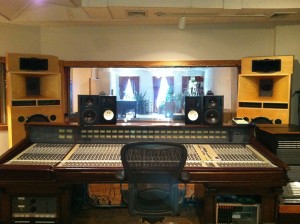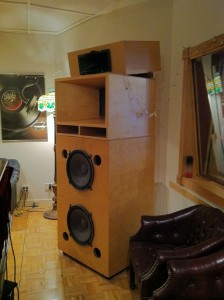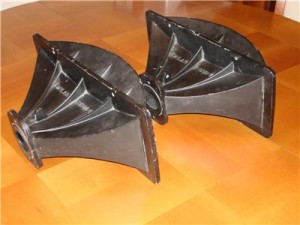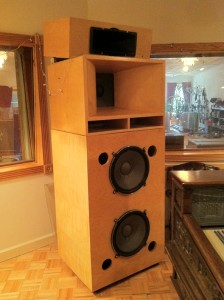Landmarks: Main Monitors, Sear Sound, Studio C
HELL’S KITCHEN: In 1999, Walter Sear added something big to the New York City studioscape: Sear Sound’s famed Studio C.
Sear and his crew put together a room that was lavished with sunlight, and as rich in atmosphere as it was in technical excellence. The tracking and mixing facility is the home of the remarkable Sear-Avalon custom console in the control room, while the spacious live room remains one of the most inspiring places to work in the city.
That same year, Sear — Studio C’s architect and designer — turned to Nashvile acoustician Steven Durr to design and build the main monitors. Here, Durr revisits the active custom 3-way monitors that help complete one of NYC’s most creative spaces — sharing a wealth of acoustics and speaker design know-how in the process.
I have been blessed all my life with great mentors, none more influential than Walter Sear. When Walter asked me to design a set of large monitor speakers for his new Studio C control room, I was honored and at the same time very nervous.
Walter was a purist and known as the ultimate “golden ears” when it came to true, natural sounding recordings. Everything in his studio had to pass the “Walter test” which could be very difficult. Walter was never short on voicing his opinion and most of the time one heard, “They can’t be serious! This sounds awful!” “Without discipline there is no art form.”; some of his favorite sayings. He demanded unparalleled quality for everything in life, even his martini.
If you ever had the opportunity to discuss anything, especially the recording process, with Walter, it became immediately apparent his standards were unique, especially in today’s world of “brief case” engineers. I, like many others, would spend hours listening and learning about things that would change my life forever. I will be forever grateful for his generosity.
To design a set of monitors for Walter, I approached the task the same way I approach everything in acoustics: It is the laws of physics, not the suggestions. Almost all published research about acoustics centers around large room acoustics, concert halls, music venues. Very little accurate research is published about small room acoustics such as audio control rooms, so there is no substitute for experience.
A Little History
In the early era of recording the most popular speaker systems used for monitoring were manufactured by Altec Lansing. Most studios chose the famous Voice of the Theater — model number A7 — or the infamous Altec 604 dual concentric speakers. These speakers dominated the recording industry.
The A7-500 was used by such greats as Willie Mitchell who mixed all of Al Green’s wonderful records sitting in front of two A7-500’s on the floor and a 50 watt tube McIntosh amplifier. This tube amplifier was never turned off in 40 years! Owen Bradley mixed all of Patsy Cline’s records at Bradley Barn in Nashville on two A7s as well; this is only two of hundreds of examples but these recordings still sound spectacular today.
The secret behind the success of the A7 speakers is the high frequency horn which has a relatively high Q of around 15 and likewise so does the horn-loaded low frequency woofer enclosure. This matching of the two horn bells made for an accurate and natural sounding speaker system. Traditionally, it is common to find a high Q horn such as a radial horn used in most speaker designs with a Q of 12 to 15 and the woofer simply flush mounted in the front board of the enclosure.
This is a complete mismatch as the low frequency in this configuration has a Q of 1 with little or no directionality match to the high frequency horn, which has very high directionality. Hence the lack of definition in the lower frequencies and smooth transition from the horn to the woofer.
Studio C Control Room
Sear Sound’s control room C is a relatively large control room with limited acoustical treatments. This limited use of sound absorbing materials means the room has a significant reverberant field including high levels of reverberant energy from multiple sources. This approach is not at all detrimental to the performance of the room; in fact it feels very natural talking and working in a room with a significant reverberant field as long as it is evenly distributed, which is the case in Studio C.
But the large reverberant field found in most control rooms is one of the main reasons engineers resorted to near field monitors because close monitoring effectively removes the room’s natural acoustics from the listening equation. But at the same time, near fields also remove the excitement and energy from the playback of the recording. This is similar to seeing a great film in a theater where it is easy to achieve the suspension of disbelief since the film experience is bigger than life, but that suspension is negated watching the same film on television. Same product, two completely different experiences. Seeing ‘Avatar’ in 3-D at IMAX and watching it on television is the extreme.
In large room acoustics the designer has two choices, raise the Q or directionality of the sound source or lower the reverberant field. Laws of physics! We could have chosen to add additional absorption to the control room but we all agreed we loved the way the room felt as it was, so the only option then was to raise the directionality or Q of the speaker system.
Studio C Monitors
For the high frequencies we chose an Emilar EH-500 horn which is a very dense metal horn. In my opinion, this is one of the best sounding small format horns ever made which will accept a 2” compression driver. A TAD 4001 2” high frequency horn driver was matched to the Emilar horn bell. Considerable care was taken to build an enclosure for the horn assembly and properly isolate the TAD driver from the horn bell and align the opening perfectly at the horn/driver intersect. These enclosures are mounted directly on top of the mid/low enclosure.
The high frequency enclosures are crossed over at 800 hertz at 18db per octave and each one is powered by a single channel of a McIntosh 2100. One of the beauties of this design is that when this type of speaker was conceived in the 1950’s a 50 watt power amplifier was the norm. This built-in efficiency allows spectacular results with relatively small amplifier power.
The mid/ low enclosures are a modified Altec 416a cabinet which is a smaller, down-sized version of the horn loaded low frequency section of a A-7 500 Voice of the Theater. We added considerable bracing and chose a JBL 2235 for the driver. The mid/low section is powered by a McIntosh 2200. This enclosure is mounted directly on top of the sub-woofer enclosure.
The sub-woofer cabinets break the mold as I could not justify a horn loaded sub-woofer enclosure due to the extreme size required for pattern control below 100 hertz. But as Paul Klipsch would say, “There is no such thing as a miniature 30 hertz wave”, so two 15” TAD 1601 b woofers on each side combine to provide a smooth low frequency response to 16 hertz. The subs are powered by a Crown Micro-reference ll power amplifier.
The entire system is mounted on five Mason Industries NA Green isolators to uncouple the speaker system from the wooden floor of building.
Processing is very simple; a modified White Instruments 4320 passive 1/3 octave equalizer and a White Instruments 4016 800 Hertz plug in crossover provide equalization and crossover from high to mid/low. Crossover between the mid/lows and the sub woofers are provided by a DBX active crossover set to 120 hertz. This is wired as a stand-alone unit, in other words nothing is running through the high pass side of the crossover, we are using it essentially as a low pass on the sub-woofers.
Very little equalization is required, mostly to match the timbre of the left and right speakers and balance the low frequency response to the room.
The system was signal aligned on site by physically aligning the flight time of the drivers at the mix positions using Smaart. Arrival times and phase response were examined and used to align drivers.
As a designer, I consider myself in the emotion business and sound systems are the transfer medium. It is paramount for the artist to feel the emotion of their music in recording or in a live performance but a monitoring system must also be extremely accurate.
Listening to this system it is impossible to tell you are listening to loudspeakers. All of the emotions are in place, depth of field is stunning and mixes translate perfectly to the outside world.
Walter would say, “You will know when something is correct in the first 17 seconds of listening,” and It makes me smile instantly every time I listen to a recording in this room – I remember the smile on his face when we first listened to these speakers.
Steven Durr, the principal designer of Steven Durr Designs, LLC, is known and respected throughout the world for his talent and common sense expertise in acoustic design and consulting.










